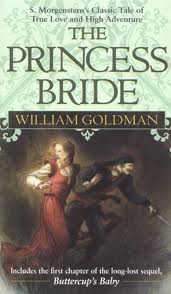The Princess Bride by S. Morgenstern and William Goldman
Reviewed by Karen

Ratings Explanation
Language: There is one reference to deity in the Princess Bride itself, but several during Goldman’s storyline interjected throughout the novel or during his editing comments. Also, two other “major” swear words are used. There are a couple of derogatory comments referring to the Spanish race.
Violence: With sword fighting between Inigo and the “man in black”, a fight between the giant and the “man in black”, and the revenge sword/knife scene between Inigo and Count Rugen, there is plenty of action. There is also a kidnapping, a planned murder of the bride, and the use of clubs.
Sexual Content: This mainly occurs in the sequel, “Buttercup’s Baby”. Buttercup reminds Westley that even though they have “true love”, they have only kissed. They engage in dialogue discussing the answer to the question, “What else is there?” Also, Goldman becomes infatuated with Morgenstern’s daughter who is using her feminine charm to entice Goldman to sign legal papers regarding manuscripts.
There is one scene where Count Rugen’s wife lustily looks at Westley in the Princess Bride.
Adult Themes: There are descriptions of Westley’s torture in the Zoo of Death by the prince and Count Rugen. Brandy is drunk excessively by Inigo. Wine and poison by iocane powder are used during the “battle of wits” between “the man in black” and Vizzini.
Synopsis
The Princess Bride is S. Morgenstern’s classic tale of true love, high adventure, pirates, princesses, giants, miracles, fencing, and even some wild beasts. That’s something for everyone to love! The original 1000 page story was edited down to 300 by Hollywood screen writer, William Goldman. The 30th anniversary edition begins with lengthy introductions of how Goldman’s father read the book to young William and why he felt the need to abridge the novel. This edition also includes an abridged version of a Princess Bride sequel, “Buttercup’s Baby”. Goldman wrote the screenplay for the 1987 movie. That is why the movie and the book are nearly one and the same (dialogue and all).
The beautiful peasant, Buttercup, loses her true love–Farm-Boy, Westley. Devastated, she reluctantly agrees to marry Florin’s Prince Humperdinck. Hoping to start a war with the neighboring country of Guilder, the Prince arranges for Buttercup to be kidnapped by mercenaries. His plan is foiled when Buttercup is rescued by a mysterious pirate, “the man in black”. She is returned to the palace, unwillingly marries the Prince and then is saved by the same group who captured her in the first place. During her adventure she meets Vizzini, a criminal philosopher, Fezzik, a gentle giant, and Inigo, the revengeful Spaniard who seeks to kill the six-fingered Count Rugen, second in command to Prince Humperdinck.
Who doesn’t love a fairytale full of sword fighting, villains, implausible rescues and, most importantly, the greatest motive for heroism—true love? Girls are magnetized by the power of “true love”. Boys feed off of the action, the torture in the Zoo of Death, and the feats of revenge. Or, that’s how it worked out for my kids. Additionally, we all loved the quirky characters. Of course, when I finished the book, I had to re-watch the movie. But remember, even if Goldman tries to convince us otherwise, “The Princess Bride” is fictitious, as are the “European” countries of Florin and Gilder.









